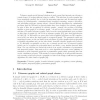Free Online Productivity Tools
i2Speak
i2Symbol
i2OCR
iTex2Img
iWeb2Print
iWeb2Shot
i2Type
iPdf2Split
iPdf2Merge
i2Bopomofo
i2Arabic
i2Style
i2Image
i2PDF
iLatex2Rtf
Sci2ools
89
Voted
STACS
2010
Springer
2010
Springer
The Recognition of Tolerance and Bounded Tolerance Graphs
Tolerance graphs model interval relations in such a way that intervals can tolerate a certain degree of overlap without being in conflict. This subclass of perfect graphs has been extensively studied, due to both its interesting structure and its numerous applications (in bioinformatics, constrained-based temporal reasoning, resource allocation, and scheduling problems, among others). Several efficient algorithms for optimization problems that are NP-hard in general graphs have been designed for tolerance graphs. In spite of this, the recognition of tolerance graphs – namely, the problem of deciding whether a given graph is a tolerance graph – as well as the recognition of their main subclass of bounded tolerance graphs, have been the most fundamental open problems
Perfect Graphs | STACS 2010 | Theoretical Computer Science | Tolerance Graphs | Tolerance Graphs Model |
Related Content
| Added | 14 May 2010 |
| Updated | 14 May 2010 |
| Type | Conference |
| Year | 2010 |
| Where | STACS |
| Authors | George B. Mertzios, Ignasi Sau, Shmuel Zaks |
Comments (0)

